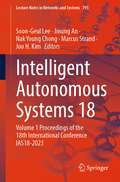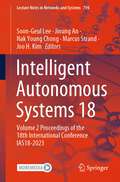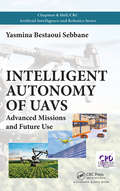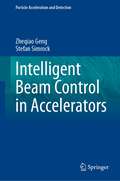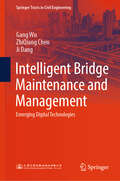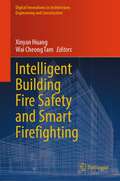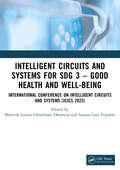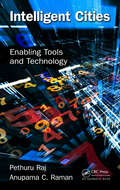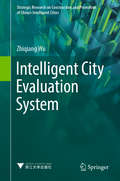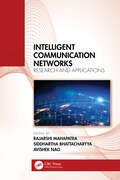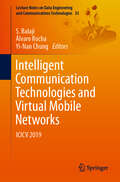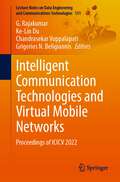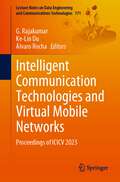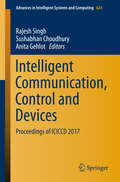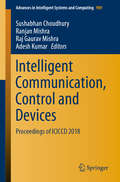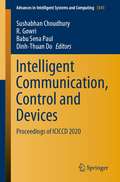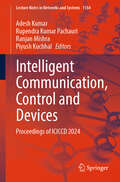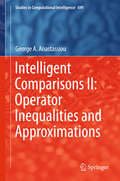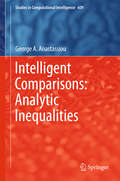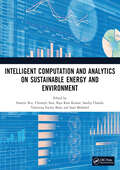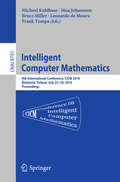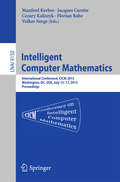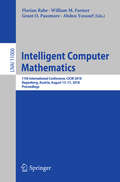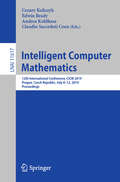- Table View
- List View
Intelligent Autonomous Systems 18: Volume 1 Proceedings of the 18th International Conference IAS18-2023 (Lecture Notes in Networks and Systems #795)
by Marcus Strand Soon-Geul Lee Jinung An Nak Young Chong Joo H. KimIntelligent autonomous systems are increasingly being applied in various fields, ranging from industrial applications to professional services and household domains. These advancements in technology and application domains have brought forth the need for continuous research and development to address new challenges in deploying intelligent autonomous systems in a reliable and user-independent manner. This book is a compilation that aims to serve researchers and practitioners in related fields by providing a timely dissemination of recent progress in the areas of autonomous mobility and robotics. The contents of this book are based on a collection of papers presented at the 18th International Conference on Intelligent Autonomous Systems (IAS18 2023), held at the Suwon Convention Center in Suwon, Korea. The conference took place fully in person from July 4 to 7, 2023, with the theme “Impact and Effect of AI on Intelligent Autonomous Systems.” It encompassed discussions on theories, applications, and creative innovations in intelligent autonomous systems, covering topics such as autonomous vehicles, intelligent agents, smart sensors and actuators, smart haptics, human–machine interaction, digital twin, digital health, and metaverse, VR, AR, or MR. For ease of reading, the 91 papers have been grouped into five chapters: Chapter 1: Intelligent Autonomous Vehicles; Chapter 2: Autonomous Robots; Chapter 3: Intelligent Perception and Sensors; Chapter 4: Data Fusion and Machine Learning for Intelligent Robots; and Chapter 5: Applied Autonomous Systems. The articles included in this book underwent a rigorous peer-review process and were presented at the IAS18-2023 conference. For researchers working in the field of intelligent autonomous systems technology, we believe this book provides valuable insights into recent advances in autonomous technologies and applications, thereby enriching their studies. We extend our heartfelt thanks to all the authors and editors who contributed to this edition.
Intelligent Autonomous Systems 18: Volume 2 Proceedings of the 18th International Conference IAS18-2023 (Lecture Notes in Networks and Systems #794)
by Marcus Strand Soon-Geul Lee Jinung An Nak Young Chong Joo H. KimIntelligent autonomous systems are increasingly being applied in various fields, ranging from industrial applications to professional services and household domains. These advancements in technology and application domains have brought forth the need for continuous research and development to address new challenges in deploying intelligent autonomous systems in a reliable and user-independent manner This book is a compilation that aims to serve researchers and practitioners in related fields by providing a timely dissemination of recent progress in the areas of autonomous mobility and robotics. The contents of this book are based on a collection of papers presented at the 18th International Conference on Intelligent Autonomous Systems (IAS18 2023), held at the Suwon Convention Center in Suwon, Korea. The conference took place fully in person from July 4 to 7, 2023, with the theme “Impact and Effect of AI on Intelligent Autonomous Systems.” It encompassed discussions on theories, applications, and creative innovations in intelligent autonomous systems, covering topics such as autonomous vehicles, intelligent agents, smart sensors and actuators, smart haptics, human–machine interaction, digital twin, digital health, and metaverse, VR, AR, or MR. For ease of reading, the 91 papers have been grouped into five chapters: Chapter 1: Intelligent Autonomous Vehicles; Chapter 2: Autonomous Robots; Chapter 3: Intelligent Perception and Sensors; Chapter 4: Data Fusion and Machine Learning for Intelligent Robots; and Chapter 5: Applied Autonomous Systems. The articles included in this book underwent a rigorous peer-review process and were presented at the IAS18-2023 conference. For researchers working in the field of intelligent autonomous systems technology, we believe this book provides valuable insights into recent advances in autonomous technologies and applications, thereby enriching their studies. We extend our heartfeltthanks to all the authors and editors who contributed to this edition.
Intelligent Autonomy of UAVs: Advanced Missions and Future Use (Chapman & Hall/CRC Artificial Intelligence and Robotics Series)
by Yasmina Bestaoui SebbaneIntelligent Autonomy of UAVs: Advanced Missions and Future Use provides an approach to the formulation of the fundamental task typical to any mission and provides guidelines of how this task can be solved by different generic robotic problems. As such, this book aims to provide a systems engineering approach to UAV projects, discovering the real problems that need to be resolved independently of the application. <P><P> After an introduction to the rapidly evolving field of aerial robotics, the book presents topics such as autonomy, mission analysis, human-UAV teams, homogeneous and heterogeneous UAV teams, and finally, UAV-UGV teams. It then covers generic robotic problems such as orienteering and coverage. The book next introduces deployment, patrolling, and foraging, while the last part of the book tackles an important application: aerial search, tracking, and surveillance. <P><P> This book is meant for both scientists and practitioners. For practitioners, it presents existing solutions that are categorized according to various missions: surveillance and reconnaissance, 3D mapping, urban monitoring, precision agriculture, forestry, disaster assessment and monitoring, security, industrial plant inspection, etc. <P><P> For scientists, it provides an overview of generic robotic problems such as coverage and orienteering; deployment, patrolling and foraging; search, tracking, and surveillance. The design and analysis of algorithms raise a unique combination of questions from many fields, including robotics, operational research, control theory, and computer science.
Intelligent Beam Control in Accelerators (Particle Acceleration and Detection)
by Stefan Simrock Zheqiao GengThis book systematically discusses the algorithms and principles for achieving stable and optimal beam (or products of the beam) parameters in particle accelerators. A four-layer beam control strategy is introduced to structure the subsystems related to beam controls, such as beam device control, beam feedback, and beam optimization. This book focuses on the global control and optimization layers. As a basis of global control, the beam feedback system regulates the beam parameters against disturbances and stabilizes them around the setpoints. The global optimization algorithms, such as the robust conjugate direction search algorithm, genetic algorithm, and particle swarm optimization algorithm, are at the top layer, determining the feedback setpoints for optimal beam qualities.In addition, the authors also introduce the applications of machine learning for beam controls. Selected machine learning algorithms, such as supervised learning based on artificial neural networks and Gaussian processes, and reinforcement learning, are discussed. They are applied to configure feedback loops, accelerate global optimizations, and directly synthesize optimal controllers. Authors also demonstrate the effectiveness of these algorithms using either simulation or tests at the SwissFEL. With this book, the readers gain systematic knowledge of intelligent beam controls and learn the layered architecture guiding the design of practical beam control systems.
Intelligent Bridge Maintenance and Management: Emerging Digital Technologies (Springer Tracts in Civil Engineering)
by Gang Wu Ji Dang ZhiQiang ChenThis book provides a timely introduction to the methodology of Intelligent Bridge Maintenance and Management (IBM&M) and a comprehensive synthesis of emerging digital technologies for realizing IBM&M. The authors, who carry research, teaching, and consulting experience in the USA, Japan, and China, present the background, principles, methods, and application examples of essential IBM&M solutions in eight dedicated chapters. The digital technologies covered in this book include: • Artificial intelligence, big data, machine learning, computer vision. • Data fusion, 3D building information, digital twin modeling, virtual and augmented reality. • Internet of things sensors, robotics including unmanned vehicles. The book targets the audience in the broader Bridge Engineering community, including academic researchers, students, bridge owners, and technology providers.
Intelligent Building Fire Safety and Smart Firefighting (Digital Innovations in Architecture, Engineering and Construction)
by Xinyan Huang Wai Cheong TamThis book provides the latest research and technology advances in building fire safety and smart firefighting. Different experts systemically review the application of new technologies like Artificial Intelligence, Internet of Things, Virtual Reality, Digitalization, and Metaverse in fire safety areas. These multi-disciplinary research and technology fusion will significantly change the fire resilience design and firefighting practices in the next 20 years. Achieving urban fire safety and resilience also plays a key role in developing future smart buildings and cities. This book attracts more young researchers into the latest multi-disciplinary fire safety research and promotes the application of the new technologies in firefighting.
Intelligent Circuits and Systems for SDG 3 – Good Health and well-being: International Conference on Intelligent Circuits and Systems (ICICS 2023)
by Suman Lata Tripathi Bhaveshkumar C. DharmaniICICS is a series of conferences initiated by School of Electronics and Electrical Engineering at Lovely Professional University. Looking at the response to the conference, the bi-annual conference now onwards will be annual. The 5th International Conference on Intelligent Circuits and Systems (ICICS 2023) will be focusing on intelligent circuits and systems for achieving the targets in Sustainable Development Goal (SDG) 3, identified as ‘Good Health and Wellbeing’ by United Nations (Refs: https://sdgs.un.org/goals/goal3, https://sdg-tracker.org/).
Intelligent Cities: Enabling Tools and Technology
by Pethuru Raj Anupama C. RamanThe emergence of highly promising and potent technologies has enabled the transition of ordinary objects into smart artifacts-providing wider connectivity of digitized entities that can facilitate the building of connected cities. This book provides readers with a solid foundation on the latest technologies and tools required to develop and enhance smart cities around the world. The book begins by examining the rise of the cloud as the fundamental technology for establishing and sustaining smart cities and enterprises. Explaining the principal technologies and platform solutions for implementing intelligent cities, the book details the role of various technologies, standards, protocols, and tools in establishing flexible homes and the buildings of the future. Examines IT platforms and tools from various product vendors Considers service-oriented architecture and event-driven architecture for smart city applications Explains how to leverage big data analytics for smart city enhancement and improved decision making Includes case studies of intelligent cities, smart homes, buildings, transports, healthcare systems, and airports The authors explore the convergence of cloud computing and enterprise architecture and present valuable information on next-generation cloud computing. They also cover the various architectural types, including enterprise-scale integration, security, management, and governance. The book concludes by explaining the various security requirements of intelligent cities as well as the threats and vulnerabilities of the various components that form the basis of the intelligent city framework, including cloud, big data, Internet of Things, and mobile technologies.
Intelligent City Evaluation System (Strategic Research on Construction and Promotion of China's Intelligent Cities)
by Zhiqiang WuThis book assesses various intelligent-city evaluation systems around the globe, and subsequently combines that assessment with local-government and enterprise practices to create an evaluation index system for quantifying the Intelligent City concept. In addition, the book provides the results of the CityIQ indicator ranking of intelligent cities in China and worldwide, a system that focuses on three of the most crucial aspects of urban development: the development environment, future trends, and construction and operation. After data sorting, calculation and dimensionless treatment, a score system ranging from 0 to 100 is created for ranking and analyzing cities. Providing unique strategies for promoting an intelligent city evaluation system, the book offers a valuable reference guide for intelligent-city decision-makers, as well as leaders in public urban economy, social welfare and environmental authorities.
Intelligent Cloud Computing
by Omer F. Rana Asma Al-Saidi Rudolf Fleischer Zakaria MaamarThis book constitutes the refereed post-conference proceedings of the First International Conference on Intelligent Cloud Computing, held in Muscat, Oman, in February 2014. The 10 revised full papers presented were carefully reviewed and selected from 18 submissions. The papers cover topics in the areas of resource management and energy efficiency and security. They include 5 invited talks from leading organizations working in cloud computing in Oman and in the region.
Intelligent Communication Networks: Research and Applications
by Siddhartha Bhattacharyya Avishek Nag Rajarshi MahapatraWith the advent of Big Data, conventional communication networks are often limited in their inability to handle complex and voluminous data and information as far as effective processing, transmission, and reception are concerned. This book discusses the evolution of computational intelligence techniques in handling intelligent communication networks. Provides a detailed theoretical foundation of machine learning and computational intelligence algorithms Highlights the state of art machine learning-based solutions for communication networks Presents video demonstrations and code snippets on each chapter for easy understanding of the concepts Discusses applications including resource allocation, spectrum management, channel estimation, and physical layer of wireless networks Demonstrates applications of machine learning techniques for optical networks The text is primarily intended for senior undergraduate and graduate students and academic researchers in fields of electrical engineering, electronics and communication engineering, and computer engineering.
Intelligent Communication Technologies and Virtual Mobile Networks: ICICV 2019 (Advances in Intelligent Systems and Computing #33)
by Álvaro Rocha S. Balaji Yi-Nan ChungThis book presents the outcomes of the Intelligent Communication Technologies and Virtual Mobile Networks Conference (ICICV 2019) held in Tirunelveli, India, on February 14–15, 2019. It presents the state of the art in the field, identifying emerging research topics and communication technologies and defining the future of intelligent communication approaches and virtual computing. In light of the tremendous growth ICT, it examines the rapid developments in virtual reality in communication technology and high-quality services in mobile networks, including the integration of virtual mobile computing and communication technologies, which permits new technologies based on the resources and services of computational intelligence, big data analytics, Internet of Things (IoT), 5G technology, automation systems, sensor networks, augmented reality, data mining, and vehicular ad hoc networks with massive cloud-based backend. These services have a significant impact on all areas of daily life, like transportation, e-commerce, health care, secure communication, location detection, smart home, smart city, social networks and many more.
Intelligent Communication Technologies and Virtual Mobile Networks: Proceedings of ICICV 2022 (Lecture Notes on Data Engineering and Communications Technologies #131)
by Ke-Lin Du Chandrasekar Vuppalapati Grigorios N. Beligiannis G. RajakumarThe book is a collection of high-quality research papers presented at Intelligent Communication Technologies and Virtual Mobile Networks (ICICV), held at Francis Xavier Engineering College, Tirunelveli, Tamil Nadu, India, during February 10–11, 2022. The book shares knowledge and results in theory, methodology and applications of communication technology and mobile networks. The book covers innovative and cutting-edge work of researchers, developers and practitioners from academia and industry working in the area of computer networks, network protocols and wireless networks, data communication technologies and network security.
Intelligent Communication Technologies and Virtual Mobile Networks: Proceedings of ICICV 2023 (Lecture Notes on Data Engineering and Communications Technologies #171)
by Ke-Lin Du Álvaro Rocha G. RajakumarThe book is a collection of high-quality research papers presented at Intelligent Communication Technologies and Virtual Mobile Networks (ICICV 2023), held at Francis Xavier Engineering College, Tirunelveli, Tamil Nadu, India, during February 16–17, 2023. The book shares knowledge and results in theory, methodology, and applications of communication technology and mobile networks. The book covers innovative and cutting-edge work of researchers, developers, and practitioners from academia and industry working in the area of computer networks, network protocols and wireless networks, data communication technologies, and network security.
Intelligent Communication, Control and Devices: Proceedings Of Iciccd 2017 (Advances In Intelligent Systems And Computing #624)
by Rajesh Singh Sushabhan Choudhury Anita GehlotThe book focuses on the integration of intelligent communication systems, control systems, and devices related to all aspects of engineering and sciences. It contains high-quality research papers presented at the 2nd international conference, ICICCD 2017, organized by the Department of Electronics, Instrumentation and Control Engineering of University of Petroleum and Energy Studies, Dehradun on 15 and 16 April, 2017. The volume broadly covers recent advances of intelligent communication, intelligent control and intelligent devices. The work presented in this book is original research work, findings and practical development experiences of researchers, academicians, scientists and industrial practitioners.
Intelligent Communication, Control and Devices: Proceedings of ICICCD 2018 (Advances in Intelligent Systems and Computing #989)
by Sushabhan Choudhury Ranjan Mishra Raj Gaurav Mishra Adesh KumarThe book focuses on the integration of intelligent communication systems, control systems, and devices related to all aspects of engineering and sciences. It includes high-quality research papers from the 3rd international conference, ICICCD 2018, organized by the Department of Electronics, Instrumentation and Control Engineering at the University of Petroleum and Energy Studies, Dehradun on 21–22 December 2018. Covering a range of recent advances in intelligent communication, intelligent control and intelligent devices., the book presents original research and findings as well as researchers’ and industrial practitioners’ practical development experiences of.
Intelligent Communication, Control and Devices: Proceedings of ICICCD 2020 (Advances in Intelligent Systems and Computing #1341)
by Sushabhan Choudhury Babu Sena Paul R. Gowri Dinh-Thuan DoThis book focuses on the integration of intelligent communication systems, control systems and devices related to all aspects of engineering and sciences. It includes high-quality research papers from the 4th International Conference on Intelligent Communication, Control and Devices (ICICCD 2020), organized by the Department of Electronics, Instrumentation and Control Engineering at the University of Petroleum and Energy Studies, Dehradun, India during 27–28 November 2020. The topics covered are a range of recent advances in intelligent communication, intelligent control, and intelligent devices.
Intelligent Communication, Control and Devices: Proceedings of ICICCD 2024 (Lecture Notes in Networks and Systems #1164)
by Ranjan Mishra Adesh Kumar Rupendra Kumar Pachauri Piyush KuchhalThis book focuses on the integration of intelligent communication systems, control systems, and devices related to all aspects of engineering and sciences. It includes high-quality research papers from the 6th International Conference on Intelligent Communication, Control and Devices (ICICCD 2024), organized by the Department of Electrical & Electronics Engineering, School of Advanced Engineering, at UPES, Dehradun, India, during May 30–31, 2024. The topics covered are a range of recent advances in intelligent communication, intelligent control, intelligent devices, and sustainable technologies.
Intelligent Comparisons II: Operator Inequalities and Approximations
by George A. AnastassiouThis compact book focuses on self-adjoint operators' well-known named inequalities and Korovkin approximation theory, both in a Hilbert space environment. It is the first book to study these aspects, and all chapters are self-contained and can be read independently. Further, each chapter includes an extensive list of references for further reading. The book's results are expected to find applications in many areas of pure and applied mathematics. Given its concise format, it is especially suitable for use in related graduate classes and research projects. As such, the book offers a valuable resource for researchers and graduate students alike, as well as a key addition to all science and engineering libraries.
Intelligent Comparisons: Analytic Inequalities
by George A. AnastassiouThis monograph presents recent and original work of the author on inequalities in real, functional and fractional analysis. The chapters are self-contained and can be read independently, they include an extensive list of references per chapter. The book's results are expected to find applications in many areas of applied and pure mathematics, especially in ordinary and partial differential equations and fractional differential equations. As such this monograph is suitable for researchers, graduate students, and seminars of the above subjects, as well as Science and Engineering University libraries.
Intelligent Computation and Analytics on Sustainable Energy and Environment: Proceedings of the 1st International Conference on Intelligent Computation and Analytics on Sustainable Energy and Environment (Conference Proceedings Series on Intelligent Systems, Data Engineering, and Optimization)
by Valentina Emilia Balas Saad Mekhilef Chiranjit Sain Amarjit Roy Raja Ram Kumar Sandip ChandaThe 1st International Conference on Intelligent Computation and Analytics on Sustainable Energy (ICICASEE 2023) was held at Ghani Khan Choudhury Institute of Engineering & Technology (GKCIET), Malda, West Bengal, India. GKCIET is a premier engineering institute located in Malda, West Bengal, India. Being established in 2010, at present the institute offers B.Tech and Diploma Civil Engineering, Mechanical Engineering, Electrical Engineering, Computer Science and engineering and Food process□ing technology. The conference was aimed to provide a platform for researchers, academicians, indus□try professionals, and students to exchange knowledge and ideas on intelligent computation, analytics, and their applications in sustainable energy systems. The Department of Electrical Engineering of the institute hosted the conference from September 21–23, 2023.
Intelligent Computer Mathematics
by Bruce Miller Frank Tompa Michael Kohlhase Moa Johansson Leonardo De MouraThis book constitutes the refereed proceedings of the 9th International Conference on Intelligent Computer Mathematics, CICM 2016, held in Bialystok, Poland, in July 2016. The 10 full papers and 2 short papers presented were carefully reviewed and selectedfrom a total of 41 submissions. The papers are organized in topical sections according to the five tracks of the conference: Calculemus; Digital Mathematics Libraries; Mathematical Knowledge Management; Surveys and Projects; and Systems and Data.
Intelligent Computer Mathematics
by Manfred Kerber Jacques Carette Cezary Kaliszyk Florian Rabe Volker SorgeThis book constitutes the refereed proceedings of the International Conference on Intelligent Computer Mathematics, CICM 2015, held in Washington, DC, USA, in July 2015. The 16 full papers and 9 short papers presented together with two invited talks plus one abstract were carefully reviewed and selected from a total of 43 submissions. The papers are organized in topical sections following the tracks of the conference: Invited Talks; Calculemus; Digital Mathematics Libraries; Mathematical Knowledge Management; Projects and Surveys; Systems and Data.
Intelligent Computer Mathematics: 11th International Conference, CICM 2018, Hagenberg, Austria, August 13-17, 2018, Proceedings (Lecture Notes in Computer Science #11006)
by Florian Rabe William M. Farmer Grant O. Passmore Abdou YoussefThis book constitutes the refereed proceedings of the 11th International Conference on Intelligent Computer Mathematics, CICM 2018, held in Hagenberg, Austria, in August 2018. The 23 full papers presented were carefully reviewed and selected from a total of 36 submissions. The papers focos on the Calculemus, Digital Mathematics Libraries, and Mathematical Knowledge Management tracks which also correspond to the subject areas of the predecessor meetings. Orthogonally, the Systems and Projects track called for descriptions of digital resources, such as data and systems, and of projects, whether old, current, or new, and survey papers covering any topics of relevance to the CICM community.
Intelligent Computer Mathematics: 12th International Conference, CICM 2019, Prague, Czech Republic, July 8–12, 2019, Proceedings (Lecture Notes in Computer Science #11617)
by Cezary Kaliszyk Edwin Brady Andrea Kohlhase Claudio Sacerdoti CoenThis book constitutes the refereed proceedings of the 12th International Conference on Intelligent Computer Mathematics, CICM 2019, held in Prague, Czech Republic, in July 2019. The 19 full papers presented were carefully reviewed and selected from a total of 41 submissions. The papers focus on digital and computational solutions which are becoming the prevalent means for the generation, communication, processing, storage and curation of mathematical information. Separate communities have developed to investigate and build computer based systems for computer algebra, automated deduction, and mathematical publishing as well as novel user interfaces. While all of these systems excel in their own right, their integration can lead to synergies offering significant added value.
